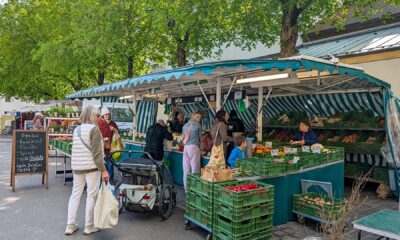A person displays a sign as labor union activists rally in support of federal workers during a protest, with the U.S. Capitol in the background on Capitol Hill in Washington, U.S., Feb. 11, 2025.
Craig Hudson | Reuters
The sudden cuts to the federal workforce under President Donald Trump will likely throw a curveball into the retirement plans of many Americans, including those from typically disadvantaged backgrounds like Black Americans.
The federal government is often seen as a stable employer with generous benefits, including a defined benefit retirement package that has become rare in corporate America.
But the recent cuts, such as the widespread culling of employees with probationary status, have made some job-seekers rethink their career paths, said Janine Wiggins, owner of Resumes by Neen, an Alabama-based job search coaching business focused on federal workers.
“They’re growing distrust toward federal jobs, just because of the mass layoffs and all of the different executive orders that have been going out. There’s a lot of volatility now. … Before, I would get a lot of clients that want to work for the government because they see it as somewhere where they can stay long-term and retire,” Wiggins said.
The full impact of the jobs cuts is to be determined. However, there’s a chance that they could impact certain minority groups at a relatively high rate, given the demographics of the federal workforce.
According to a study by the U.S. Government Accountability Office, Black American workers made up just under 20% of the federal workforce in 2021. Recent data from the Bureau of Labor Statistics puts the Black American share of the civilian workforce at roughly 13%. Other groups with relatively higher representation in the federal workforce include Native Americans and people with disabilities.
One of those current employees is Katrina Ayers, a 36-year old African American mother of three in Mobile, Alabama, who works as a technician for the National Guard.
“What attracted me to was of course job security and the health insurance. That was the biggest thing. It was something that was stable,” Ayers said. She has been a federal employee for nine years.
Ayers said that she has private retirement savings, including a Roth IRA, in addition to her federal benefits. Still, she says she knows some federal workers rely solely on the government plans.
Federal retirement benefits
The retirement package for most federal workers consists of three main programs: Social Security, a 401(k)-like Thrift Savings Plan, and an annuity program called the Basic Benefit Plan. The minimum retirement age for the annuity plan is 57 years old for workers born in 1970 or later. There are options of deferred or early retirements for workers who meet certain thresholds.
That basic annuity is calculated using years of service and the highest average pay during three consecutive years of service, so even employees who are eligible for the program could end up with a lower-than-expected benefit if they are pushed out. Employees who are separated from their federal jobs before they are eligible for retirement can receive a lump sum of their retirement contributions.
The 401(k)-style Thrift Savings Plan is better than the average 401(k) plan found in the private sector, said J. Mark Iwry, who is currently a nonresident senior fellow at the Brookings Institution and a visiting scholar at the Wharton School. He previously served as senior advisor to the secretary of the Treasury from 2009 to 2017.
The defined benefit pension plan for many federal workers provides a somewhat lower level of benefits than some of the comparable private sector plans that are still in operation, Iwry said. However, the federal plan does have the rare perk of being largely adjusted for inflation.
Of course, the impact on retirement savings can also depend on how long it takes for workers to find a new job, and if they need to liquidate some of their assets in the meantime.
“You may end up having a need to tap your retirement savings that you wouldn’t if you didn’t have to change jobs,” said Craig Copeland, director of wealth benefits research with the Employee Benefit Research Institute.
Some workers in lower-income communities or with lower family wealth may also have more people to support, putting additional strain on their finances. This could be a reason that, at higher levels of income, there’s some evidence that Black workers save less than their white counterparts, Copeland said.
“The wealthier individuals that are Black or Hispanic felt that they had more of a responsibility to care for other loved ones than save for their retirement. So that limited somewhat of how much they saved,” Copeland said.
In general, the wealth gap between Black and white savers has been widening due to an array of factors, including Black households having less exposure to the stock market, existing barriers to Black homeownership and the undervaluation of homes in communities of color. This disparity in wealth also continues to grow as people age.
What’s next
The exact extent of the job cuts among federal workers is unclear. Several legal challenges have already been filed against Elon Musk’s Department of Government Efficiency, which has been pushing for some of the job cuts. Tech executive Musk took a similar cost-cutting approach when he bought the company formerly known as Twitter.
The government has also done some backtracking, such as the U.S. Food and Drug Administration re-hiring some of medical device division staff, suggesting that some of the eliminated roles may need to be filled again in the near future.
“People make the country run. So you need people in place, and to lay off all these federal workers, I’m just not understanding the rhyme and reason why, because I just feel like it’s going to be a domino effect,” Ayers said.
For her part, Ayers said that she has a backup plan if she needs to transition full-time into the private sector but isn’t ready to give up on her career with the federal government just yet.
“I’m going to still apply for jobs because I still believe in career progression, and I would like to stay on in the federal sector since I’ve invested so many years,” Ayers said.

 Economics1 week ago
Economics1 week ago
 Economics6 days ago
Economics6 days ago
 Personal Finance6 days ago
Personal Finance6 days ago
 Accounting7 days ago
Accounting7 days ago
 Personal Finance1 week ago
Personal Finance1 week ago
 Economics1 week ago
Economics1 week ago
 Blog Post3 days ago
Blog Post3 days ago
 Finance6 days ago
Finance6 days ago






















